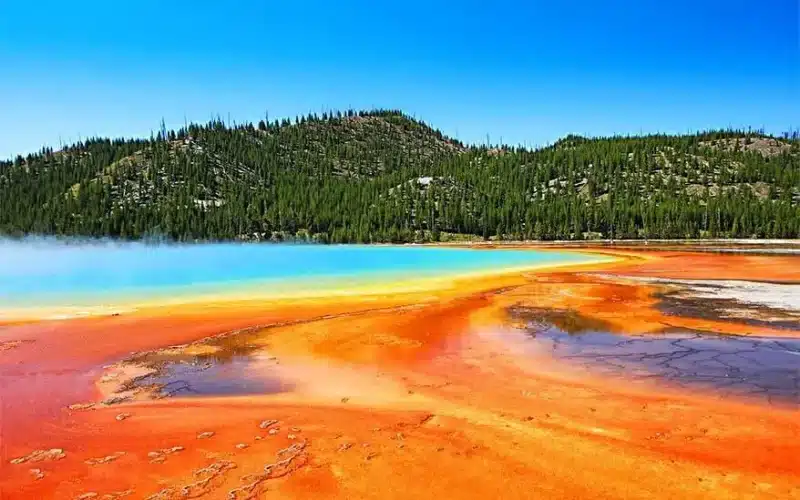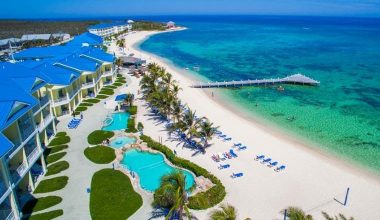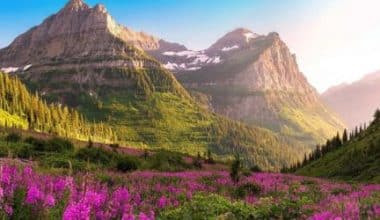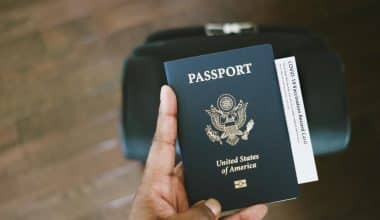During peak season (June, July, and August), Yellowstone National Park can become extremely crowded. So the short answer is that it is best to visit Yellowstone in April, September, and October. These “off-season” months offer more opportunities to see local wildlife and enjoy fewer crowds. Bears awaken from their winter hibernation between March and April, migrating birds arrive just before May, and the elk rut begins in mid-September. But let’s get into more details… If you want to visit the park, here are the best time to go and how to avoid crowds during your visit.
When is Yellowstone’s Peak Season?
Yellowstone’s peak season begins in late April and lasts until mid-September. May, June, July, and August draw hundreds of thousands of visitors to the park (overall, the park hosted 3,806,305 visitors in 2020), resulting in increased traffic and longer wait times at the more popular landmarks.
Best Time to Visit Yellowstone National Park
If you want to visit Yellowstone this year, we recommend going during the months listed below.
April
Nothing beats seeing Yellowstone’s natural landscape come to life in the spring. This time of year is also very active for local wildlife, and it’s a great time to see bears, wolves, elk, moose, and other animals emerge from their winter dens.
Activities to Try
- Snowshoeing
- Observing wildlife
- Hiking
- Camping
Bring warm clothing and weather-appropriate gear. Temperatures and weather in Yellowstone can vary greatly during this time!
September
September still has some of the warmer temperatures of peak season, but not as many visitors! The majority of the park’s roads are still open, and the local wildlife can be seen throughout the park.
Activities to Try
- Fishing
- Camping
- Backpacking
- Hiking
- Observing wildlife
Bring warm clothing and weather-appropriate gear. Temperatures and weather in Yellowstone can vary greatly during this time!
October
Yellowstone’s natural landscape shifts as the warmer temperatures begin to cool, providing a unique opportunity to view the park as winter approaches. October also allows visitors to enjoy the park’s geysers, hot springs, and natural vents without having to fight through crowds.
Activities to Try
- Hiking
- Camping
- Backpacking
- Wildlife Observation
When to Visit Yellowstone to Avoid Crowds
Although many people are hesitant to plan outdoor vacations during the winter, they can be the most rewarding. When winter arrives in Yellowstone National Park, snow blankets the mountainous terrain, leaving the most popular attractions blissfully empty. Yellowstone National Park has some of the most overlooked backcountry skiing in the country for the adventurous (and those willing to brave the biting cold). Just make sure to check for road closures ahead of time, as they can scupper your plans to visit Yellowstone.
The Best Time to Visit Yellowstone National Park for Wildlife
Wildlife can be seen all year at Yellowstone, though the season’s influence which species you see. The best months to see bears are March and April, while the winter months are ideal for seeing wolves and bighorn sheep. During the summer, which is also the park’s busiest season, visitors can see elk, moose, bison, and mountain goats.
In contrast, fall is a great time to see bears, elk, and raptors — all while enjoying more pleasant weather. When viewing wildlife, keep a safe distance for your own safety as well as the animals’. The park expressly prohibits visitors from approaching wildlife to take photographs or selfies.
When Is the Best Time to Photograph in Yellowstone?
It could be argued that there is no bad time for photographers to visit Yellowstone. However, during peak season, there will almost certainly be other people in those shots. Visitors who want to photograph Yellowstone should go during the winter months when the park is much less crowded (no families huddled around Old Faithful). The winter months are also ideal for photographing snowfall and steam rising from hot springs and geysers.
Yellowstone’s Best Weather
Yellowstone’s weather can be unpredictable all year due to its high elevation. Temperatures in the spring and fall range from 30 to 60 degrees Fahrenheit, with lows occasionally approaching 0 degrees. Summer highs typically range between 70 and 80 degrees, though cold nights can bring frost and freezing temperatures.
Temperatures can vary greatly depending on elevation, as they do in all mountainous areas. Travelers don’t need to worry about traveling during (or avoiding) a rainy season because average precipitation is fairly consistent across all seasons.
When Is the Worst Time to Visit Yellowstone?
Winter, unless you plan on skiing, may be one of the most inhospitable times to visit Yellowstone, with highs rarely exceeding 20 degrees Fahrenheit.
Winter, on the other hand, can be preferable to summer, which is the busiest time of year at Yellowstone, if you’d rather bundle up than mingle with throngs of other travelers.
The Most Economical Season to Visit Yellowstone
Flights to Jackson Hole, Wyoming’s nearest major airport, are typically the cheapest between October and February when the park is closed. After Labor Day, when the summer crowds have dissipated, and children have returned to school, lodging prices begin to fall. Keep in mind that road closures typically begin in late September or October, depending on the weather, so plan accordingly.
Weather and Visitation in Yellowstone National Park by Month Before we get into the specifics of what’s open, where to stay, and other logistical considerations, let’s take a look at the weather and visitation each month.
Yellowstone National Park in January
In Yellowstone National Park, January is the dead of winter, with freezing days and even colder nights. Because of the heavy snowfall, much of the park is inaccessible except by snowmobile. Those who visit Yellowstone, however, are greeted with unprecedented solitude and incredible opportunities for wildlife viewing, such as wolves and bighorn sheep.
Yellowstone National Park in February
In Yellowstone, February is similar to January, with freezing temperatures and heavy snowfall. As a result, February is the ideal month for visitors who want to stay at the unique Old Faithful Snow Lodge and experience the park in the dead of winter.
Yellowstone National Park in March
The weather is starting to warm up (though many days remain below freezing). Snowfall is still heavy, but less so than during the peak winter months. The month of March is ideal for viewing bears as they emerge from the cold winter weather.
Yellowstone National Park in April
In mid-April, snowfall begins to diminish, and visitors who don’t mind the cold weather and road closures return to the park. By the end of April, daily visitors have risen in anticipation of the busy summer tourism season. April, like March, is an excellent month to see bears in Yellowstone.
Yellowstone in May
May is an excellent time to visit Yellowstone National Park. Wildlife is out in force as the snow melts. There will be newborn bison and young elk, as well as wildflowers. Daily visitors increase significantly beginning in May, but crowds remain much thinner than in summer.
Yellowstone National Park in June
After Memorial Day, visitor numbers begin to peak for the summer. All park amenities and trails are open, and popular attractions such as Old Faithful and Grand Prismatic Spring are crowded all day. Having said that, the weather is spectacular right now. The weather is pleasant during the day, the wildflowers are in full bloom, and it’s an ideal time for hiking.
Yellowstone in July
With over a million visitors (nearly 35,000 per day! ), July is the busiest month in Yellowstone National Park. Expect to book your lodging months in advance, with crowded trails and long wait times at restaurants. The weather is beautiful, and all paths are clear of snow, but be prepared to battle crowds. If you visit in July, the best time to explore is around sunrise or sunset.
Yellowstone National Park in August
August is also a popular month to visit Yellowstone, though crowds are generally lighter than in July. Wildlife, such as bison, can be found everywhere. Expect trails and geyser basins to be crowded, as they were in July. To avoid crowds, go exploring around sunrise or sunset.
Yellowstone National Park in September
Yellowstone sees an increase in visitors during the Labor Day weekend. Crowds thin out after Labor Day, making mid-September one of the best times to visit Yellowstone National Park. Furthermore, September is elk, bison, and bear mating season, so sightings of these animals are common.
Yellowstone National Park in October
If you want to avoid crowds while still seeing Yellowstone without snow, October is a great time to visit. The weather in early October is cool, but daytime temperatures remain above freezing. By the end of October, park roads and lodging will be closed in preparation for the harsh winter ahead.
Yellowstone National Park in November
Visitors decreased significantly in November compared to October. Fewer visitors come because heavy snowfall begins in November, and much of the park is closed (except for Mammoth, which is open all year).
Yellowstone National Park in December
Yellowstone National Park has the fewest visitors in December. With fewer than 1,000 visitors per day, now is the time to go for unparalleled solitude. The Old Faithful Snow Lodge opens in mid-December, making it ideal for those looking for a unique holiday experience.
Tips for Avoiding the Crowds in Yellowstone
Aside from visiting during the off-season, there are a few simple things you can do to avoid crowds and see more of the park. All it takes is a little forethought.
Arrive on time
Yellowstone’s crowds will be at their peak in the early morning and late afternoon, so arriving as early as possible will give you easy access to the landmarks you want to see.
Choose the sights that are hidden, secret, or less well-known
Hundreds of thousands of geysers, hydrothermal features, and natural landmarks can be found in Yellowstone. Choose a few lesser-known sights, and you’ll have easy access to some of the park’s more unique features.
Hike to a higher vantage point
While most of Yellowstone’s landmarks can be seen up close and personal, a few can be seen from a higher vantage point. The Fairy Falls trail, for example, takes you directly above the Grand Prismatic Spring.
Related Articles
- 31 Best Places to Travel in December in the USA 2023
- BEST NATIONAL PARKS IN THE U.S.
- BEST PLACES TO LIVE IN MONTANA: All You Need to Know
- Boot Brands: The Comprehensive Best 2023 Picks.





